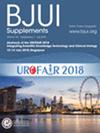The benefits of PCNL combined with ureterorenoscopy compared to isolated PCNL in urolithiasis (PRECISE): a multicentre randomised controlled trial protocol.
IF 4.4
2区 医学
Q1 UROLOGY & NEPHROLOGY
引用次数: 0
Abstract
BACKGROUND Percutaneous nephrolithotomy (PCNL) often fails to achieve complete stone clearance with a single procedure. Residual fragments, irrespective of size, are associated with increased stone-related morbidity and a higher likelihood of re-intervention. Endoscopic combined intrarenal surgery (ECIRS), which integrates PCNL with retrograde ureterorenoscopy, may improve stone-free rates and reduce morbidity. However, given the potential for increased risks and greater resource utilisation, a comprehensive randomised controlled trial is warranted. The 'PRECISE' trial is designed to compare ECIRS and PCNL in terms of efficacy, safety, stone-related morbidity, and resource utilisation. STUDY DESIGN The PRECISE is a prospective, non-blinded, randomised, parallel-group, multicentre interventional trial involving patients eligible for percutaneous kidney stone surgery. Patients will be randomised in a 1:1 ratio to undergo either ECIRS or standard PCNL. ENDPOINTS The primary endpoint is the Grade A (0 mm) stone-free rate on postoperative computed tomography (CT) at 4 weeks. Secondary radiological endpoints include Grade B (≤2 mm) and Grade C (≤4 mm) stone-free rates at 4 weeks, stone volume reduction, 1-year stone-free rates, and radiation exposure. Additional outcomes include complications, operative duration, stone-related events (SREs), health-related quality of life (HRQoL), cost differences, cost-effectiveness and environmental impact, assessed up to 5 years postoperatively. PATIENTS AND METHODS Adults (aged ≥18 years) eligible for percutaneous kidney stone surgery, where retrograde access is feasible, will be recruited. The main exclusion criteria comprise papillary calcifications, renal transplant procedures, and (suspected) pregnancy. A total of 350 patients (175 per arm) will be recruited. Follow-up includes CT imaging with clinical consultations at 4 weeks and 1 year to evaluate radiological outcomes, complications, SREs, and HRQoL. Telephone interviews at 3 and 5 years will assess long-term SREs and HRQoL. We aim to retrospectively evaluate cost differences, cost-effectiveness, and environmental impact. TRIAL REGISTRATION The PRECISE study: an investigation into combined kidney stone surgery, Dutch Trial Registry, NL-009577.与单独PCNL相比,PCNL联合输尿管镜治疗尿石症的益处(PRECISE):一项多中心随机对照试验方案。
背景:经皮肾镜取石术(PCNL)往往不能一次完全清除结石。残余碎片,无论大小,都与结石相关的发病率增加和再干预的可能性增加有关。内镜联合肾内手术(ECIRS),将PCNL与逆行输尿管镜相结合,可以提高结石的清除率并降低发病率。然而,考虑到潜在的风险增加和更大的资源利用率,有必要进行全面的随机对照试验。“PRECISE”试验旨在比较ECIRS和PCNL的疗效、安全性、结石相关发病率和资源利用率。PRECISE是一项前瞻性、非盲、随机、平行组、多中心介入试验,纳入符合经皮肾结石手术条件的患者。患者将按1:1的比例随机分配,接受ECIRS或标准PCNL。主要终点是术后4周计算机断层扫描(CT)显示的A级(0 mm)无结石率。次要放射终点包括4周时B级(≤2mm)和C级(≤4mm)结石清除率、结石体积减少、1年结石清除率和辐射暴露。其他结果包括并发症、手术时间、结石相关事件(SREs)、健康相关生活质量(HRQoL)、成本差异、成本效益和环境影响,评估时间长达术后5年。患者和方法:将招募符合经皮肾结石手术条件的成年人(年龄≥18岁),其中逆行通路是可行的。主要的排除标准包括乳头状钙化、肾移植手术和(疑似)妊娠。总共将招募350名患者(每组175名)。随访包括4周和1年的CT成像和临床会诊,以评估放射学结果、并发症、SREs和HRQoL。3年和5年的电话访谈将评估长期SREs和HRQoL。我们旨在回顾性地评估成本差异、成本效益和环境影响。试验注册the PRECISE研究:联合肾结石手术的调查,荷兰试验注册中心,NL-009577。
本文章由计算机程序翻译,如有差异,请以英文原文为准。
求助全文
约1分钟内获得全文
求助全文
来源期刊

BJU International
医学-泌尿学与肾脏学
CiteScore
9.10
自引率
4.40%
发文量
262
审稿时长
1 months
期刊介绍:
BJUI is one of the most highly respected medical journals in the world, with a truly international range of published papers and appeal. Every issue gives invaluable practical information in the form of original articles, reviews, comments, surgical education articles, and translational science articles in the field of urology. BJUI employs topical sections, and is in full colour, making it easier to browse or search for something specific.
 求助内容:
求助内容: 应助结果提醒方式:
应助结果提醒方式:


